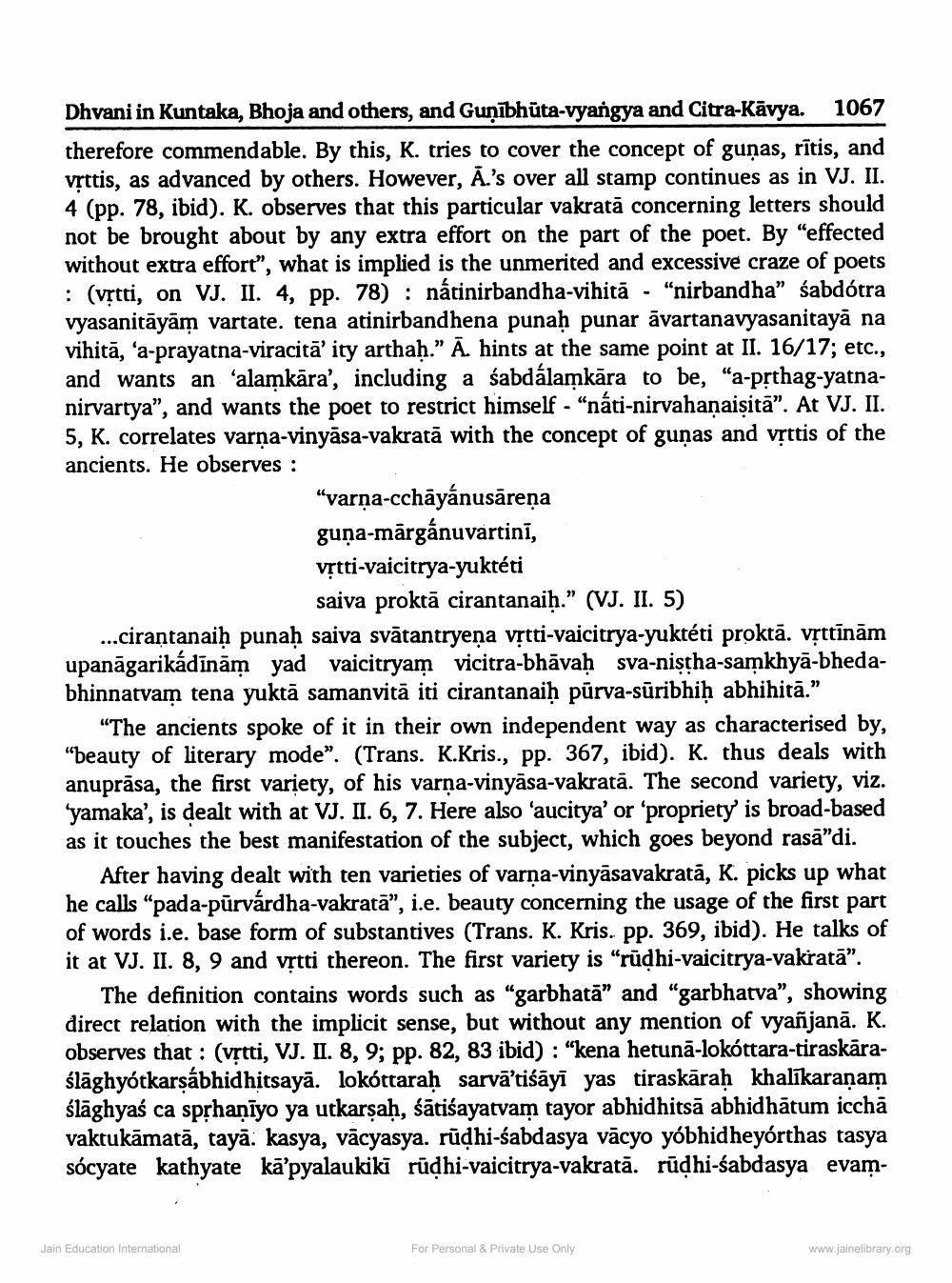________________
Dhvani in Kuntaka, Bhoja and others, and Gunībhūta-vyangya and Citra-Kāvya. 1067 therefore commendable. By this, K. tries to cover the concept of guņas, rītis, and vrttis, as advanced by others. However, A.'s over all stamp continues as in VJ. II. 4 (pp. 78, ibid). K. observes that this particular vakrată concerning letters should not be brought about by any extra effort on the part of the poet. By "effected without extra effort", what is implied is the unmerited and excessive craze of poets : (vrtti, on VJ. II. 4, pp. 78) : nátinirbandha-vihitā - "nirbandha" sabdótra vyasanitāyām vartate. tena atinirbandhena punaḥ punar avartanavyasanitayā na vihitā, 'a-prayatna-viracitā' ity arthaḥ.” Ā. hints at the same point at II. 16/17; etc., and wants an 'alamkāra', including a śabdálamkāra to be, “a-prthag-yatnanirvartya”, and wants the poet to restrict himself - “náti-nirvahanaiṣitā”. At VJ. II. 5, K. correlates varna-vinyāsa-vakratā with the concept of gunas and vrttis of the ancients. He observes :
"varņa-cchāyánusāreņa guna-mārgánuvartini, vịtti-vaicitrya-yuktéti
saiva proktā cirantanaiḥ.” (VJ. II. 5) ...cirantanaiḥ punaḥ saiva svātantryeņa vstti-vaicitrya-yuktéti proktā. vịttīnām upanāgarikádīnām yad vaicitryam vicitra-bhāvaḥ sva-nişgha-samkhyā-bhedabhinnatvam tena yuktā samanvitā iti cirantanaih pūrva-sūribhih abhihita.”
"The ancients spoke of it in their own independent way as characterised by, "beauty of literary mode". (Trans. K.Kris., pp. 367, ibid). K. thus deals with anuprāsa, the first variety, of his varņa-vinyāsa-vakratā. The second variety, viz. yamaka', is dealt with at VJ. II. 6, 7. Here also 'aucitya' or 'propriety' is broad-based as it touches the best manifestation of the subject, which goes beyond rasā"di.
After having dealt with ten varieties of varņa-vinyāsavakratā, K. picks up what he calls “pada-pūrvárdha-vakratā”, i.e. beauty concerning the usage of the first part of words i.e. base form of substantives (Trans. K. Kris. pp. 369, ibid). He talks of it at VJ. II. 8, 9 and vịtti thereon. The first variety is "rūdhi-vaicitrya-vakratā”.
The definition contains words such as "garbhatā" and "garbhatva”, showing direct relation with the implicit sense, but without any mention of vyañjanā. K. observes that : (vrtti, VJ. II. 8, 9; pp. 82, 83 ibid) : “kena hetunā-lokóttara-tiraskāraślāghyótkarşábhidhitsayā. lokóttaraḥ sarvā’tiśāyī yas tiraskāraḥ khalīkaranam ślāghyaś ca sprhanīyo ya utkarşaḥ, śātiśayatvam tayor abhidhitsă abhidhātum icchā vaktukāmatā, tayā: kasya, vācyasya. rūdhi-sabdasya vācyo yóbhidheyórthas tasya sócyate kathyate kā’pyalaukiki rūdhi-vaicitrya-vakratā. rūdhi-sabdasya evam
Jain Education International
For Personal & Private Use Only
www.jainelibrary.org




